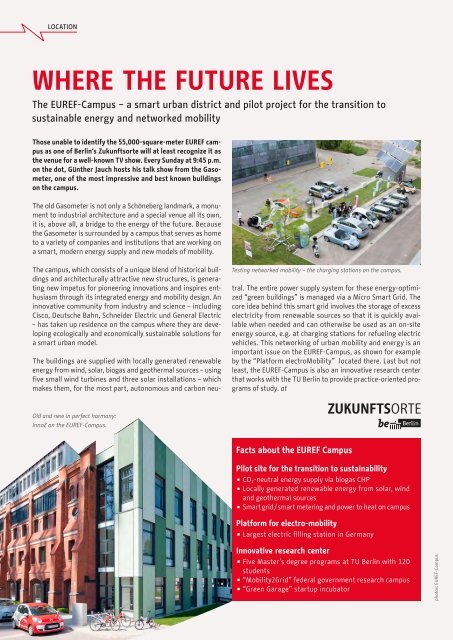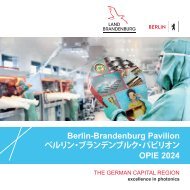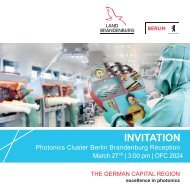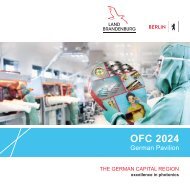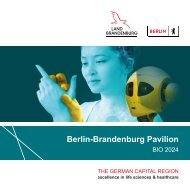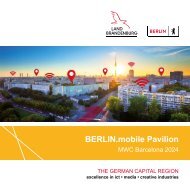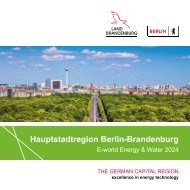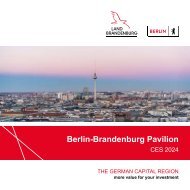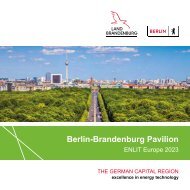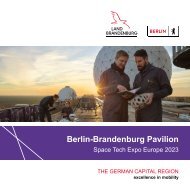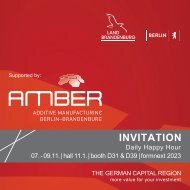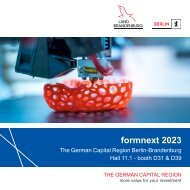Berlin to go, english edition 1/2015
Create successful ePaper yourself
Turn your PDF publications into a flip-book with our unique Google optimized e-Paper software.
LOCATION<br />
WHERE THE FUTURE LIVES<br />
The EUREF-Campus – a smart urban district and pilot project for the transition <strong>to</strong><br />
sustainable energy and networked mobility<br />
Those unable <strong>to</strong> identify the 55,000-square-meter EUREF campus<br />
as one of <strong>Berlin</strong>‘s Zukunftsorte will at least recognize it as<br />
the venue for a well-known TV show. Every Sunday at 9:45 p.m.<br />
on the dot, Günther Jauch hosts his talk show from the Gasometer,<br />
one of the most impressive and best known buildings<br />
on the campus.<br />
The old Gasometer is not only a Schöneberg landmark, a monument<br />
<strong>to</strong> industrial architecture and a special venue all its own,<br />
it is, above all, a bridge <strong>to</strong> the energy of the future. Because<br />
the Gasometer is surrounded by a campus that serves as home<br />
<strong>to</strong> a variety of companies and institutions that are working on<br />
a smart, modern energy supply and new models of mobility.<br />
The campus, which consists of a unique blend of his<strong>to</strong>rical buildings<br />
and architecturally attractive new structures, is generating<br />
new impetus for pioneering innovations and inspires enthusiasm<br />
through its integrated energy and mobility design. An<br />
innovative community from industry and science – including<br />
Cisco, Deutsche Bahn, Schneider Electric und General Electric<br />
– has taken up residence on the campus where they are developing<br />
ecologically and economically sustainable solutions for<br />
a smart urban model.<br />
Testing networked mobility – the charging stations on the campus.<br />
The buildings are supplied with locally generated renewable<br />
energy from wind, solar, biogas and geothermal sources – using<br />
five small wind turbines and three solar installations – which<br />
makes them, for the most part, au<strong>to</strong>nomous and carbon neutral.<br />
The entire power supply system for these energy-optimized<br />
“green buildings” is managed via a Micro Smart Grid. The<br />
core idea behind this smart grid involves the s<strong>to</strong>rage of excess<br />
electricity from renewable sources so that it is quickly available<br />
when needed and can otherwise be used as an on-site<br />
energy source, e.g. at charging stations for refueling electric<br />
vehicles. This networking of urban mobility and energy is an<br />
impor tant issue on the EUREF-Campus, as shown for example<br />
by the “Platform electroMobility” located there. Last but not<br />
least, the EUREF-Campus is also an innovative research center<br />
that works with the TU <strong>Berlin</strong> <strong>to</strong> provide practice-oriented programs<br />
of study. at<br />
Old and new in perfect harmony:<br />
InnoZ on the EUREF-Campus.<br />
Facts about the EUREF Campus<br />
Pilot site for the transition <strong>to</strong> sustainability<br />
• CO 2 -neutral energy supply via biogas CHP<br />
• Locally generated renewable energy from solar, wind<br />
and geothermal sources<br />
• Smart grid / smart metering and power <strong>to</strong> heat on campus<br />
Platform for electro-mobility<br />
• Largest electric filling station in Germany<br />
Innovative research center<br />
• Five Master’s degree programs at TU <strong>Berlin</strong> with 120<br />
students<br />
• “Mobility2Grid” federal <strong>go</strong>vernment research campus<br />
• “Green Garage” startup incuba<strong>to</strong>r<br />
pho<strong>to</strong>s: EUREF-Campus


